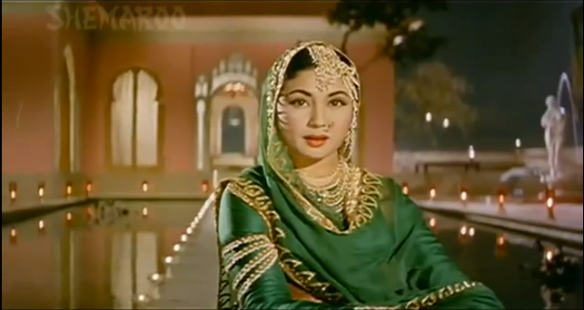Fans of vintage Hindi films are intimately familiar with the theme of female ornamentation, which is expressed beautifully through song lyrics from this period of cinema. Countless songs from the Golden Era describe the charms of a woman’s kajraa (kohl), gajraa (flower garland), jhumkaa (earring), bi.ndii (beauty spot), ka.nganaa (bangle), and so on. In addition to these words, another common term that you might encounter in this genre of songs is solaah si.ngaar, which literally means “sixteen embellishments.”
The most famous example of this phrase occurs in a song from the eternally beautiful film Pakeezah. In “ThaaDe rahiiyo, o baa.nke yaar,” Lata Mangeshkar, on Meena Kumari, sings:
mai.n to kar aauu.n solaah si.ngaar / (I will come, adorned with the sixteen embellishments)
ThaaDe rahiiyo, o baa.nke yaar / (Keep waiting, oh beautiful lover)
The term solaah si.ngaar refers to sixteen ways in which brides of ancient India adorned themselves before meeting their groom. Although sources conflict over the inclusion of certain ornaments, I am presenting a list of the most commonly accepted beautification aids associated with solaah si.ngaar below.
1. bi.ndii, a beauty spot adorning the forehead.
2. si.nduur, a sacred mark of vermillion lining the parting of a bride’s hair. si.nduur is still applied as a sign of marriage by modern Indian women.
3. maa.ng tiikaa, a gold pendant that hangs over the bride’s forehead.
4. a.njanaa or kaajal, the decoration of the bride’s eyes using kohl.
5. naath, a hoop-shaped nose ring.
6. haar, intricate necklaces made of gold and precious stones. The most auspicious necklace offered to the bride during a Hindu wedding is the mangalsutra, which symbolizes the inseparable bond between husband and wife.

Mangalsutras often contain a gold pendant on a chain of black beads as shown here.
7. karan phuul, large earrings that cover the bride’s entire ear.
8. maha.ndii, henna designs drawn on the bride’s hands and feet.
9. chuuDii, sets of bangles adorning the bride’s wrists.
10. baajuba.nd, armlets adorning the bride’s upper arms.
11. aarsii, a flat jeweled mirror worn as a ring. Supposedly, it was used by brides to check their appearance and possibly sneak a look at their grooms before the official unveiling!
12. keshaa-pashaa-rachnaa, the styling of the bride’s hair in traditional patterns and adornment of the hair with jewelry and gajraa (flower garlands).
13. kamarba.nd, a waist band made of gold and precious gems. The etymologists among our readers might notice the uncanny similarity of this word to cummerbund, the broad waist sash worn by men with tuxedos.
14. paayal, a chain adorned with small bells, often made of silver, worn around the ankle.
15. itar, fragrant oils and perfumes to keep the bride smelling fresh throughout the ceremony.
16. saarii/laha.ngaa, the bridal dress. Popular colors include red, green, and gold.

In Utsav (1984), Rekha is bedecked with many of the common ornaments that constitute solaah si.ngaar: maa.ng tiikaa, kaajal, maa.ng tiikaa, naath, haar, karan phuul, chuuDii, baajuba.nd, and kamarba.nd.
As you can see, solaah si.ngaar takes make-up to a whole new level of complexity and depth! Thankfully, modern Indian brides aren’t expected to keep up most of these practices past their wedding day in order to please their husbands. We can only imagine how much time and effort brides in ancient India must have spent on perfecting their appearances through this elaborate regimen of beautification.
This post was inspired by a question about solaah si.ngaar by one of our readers paasha. If you have any more burning questions about vintage Hindi cinema, feel free to shoot us a line–we’ll do our best to solve your Bollywood mystery! Until next time…




